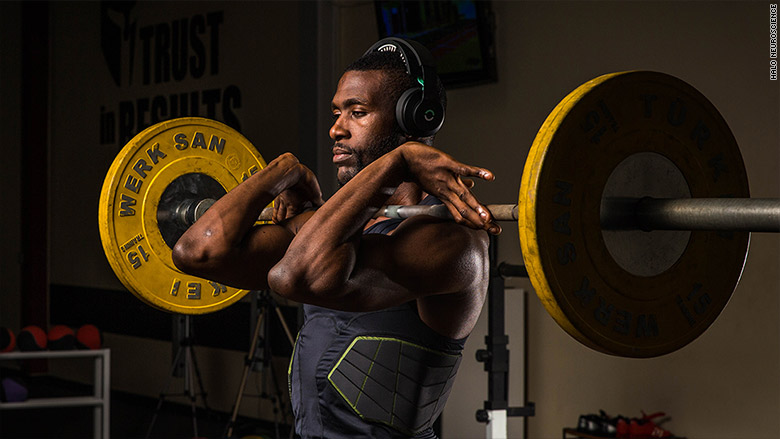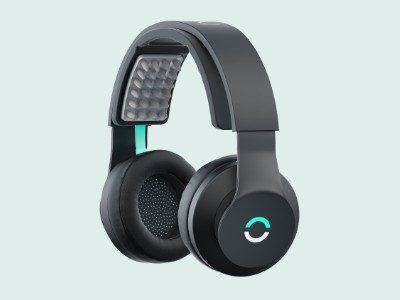
For elite athletes, every little bit of improvement counts: each second shaved off the sprint, every inch gained in the vertical leap, all of the propelling force in the takeoff.
A new startup called Halo Neuroscience says its Sport headphones can help athletes attain that critical edge -- by delivering electric pulses directly to the brain right before a workout, boosting the effectiveness of training sessions.
"We have a saying internally that champions are built, not born," Halo cofounder Daniel Chao told CNNMoney. "We want to be able to help them build in an even better way."
To those unfamiliar with the growing world of cerebrum-zapping wearables, the premise sounds bizarre: Hit my brain with electricity, and somehow I'll become better, stronger, more powerful? But Halo sold out of its first run of $549 Sport headphones earlier this year, and it plans to open up another round of orders within a few weeks.
The Halo Sport is aimed at elite athletes (it's already in use by three MLB and two NBA teams, multiple NFL players and the U.S. Ski Team, Chao said). Here's how it works.

It's electrifying
Halo Sport wearers download an iOS app that pairs with the device, which looks like a pair of Beats headphones (Susan Paley, ex-CEO of Beats By Dre, is a Halo advisor).
Twenty minutes before a workout, the athlete snaps foam-covered electrodes into the Sport and puts it on. Then the "neuropriming" session begins, sending electric pulses through the scalp to the motor cortex. A little sound plays when the session is complete, and the athlete removes the Sport and trains as usual. The effects last for an hour, Chao said.
Chao is proudest of Halo's results with athletes on the U.S. Ski Team: Ski jumpers who trained with Halo Sport improved their "jump force" by 31%, compared with an 18% increase in a control group that did the same training without the device.
"They got an extra two inches of vertical leap," Chao said. "In an elite athlete population, that is a huge win. That can be the difference between getting on or off the [medals] podium."
The science
Halo coined (and trademarked) the marketing-friendly word "neuropriming," but the scientific term for it is transcranial direct current stimulation (tDCS).
The tDCS method uses electrodes to deliver a constant, low-intensity direct electrical current to the brain. The goal of tDCS in general is to get neurons to work together and create functional connections. Halo Sport specifically targets the brain's motor cortex, which controls the movement of various muscles. That increased neuronal excitability, Chao said, improves athletes' strength and skill acquisition.
"The saying goes, 'Neurons that fire together wire together,'" Chao said. "When neurons fire in synchronicity, they recognize a special event just happened. That ... [creates] a new circuit, which is the underpinning of how we learn."
TDCS has not been approved by the Food and Drug Administration, but some studies have suggested it may help treat neuropsychiatric conditions including Parkinson's disease and chronic pain. Chao and fellow Halo cofounder Brett Wingeier formerly worked at NeuroPace, which developed a neurostimulation device to treat epilepsy patients.
But last year an Australian neuroscientist conducted a meta-analysis of more than 200 tDCS studies and concluded the method had "no evidence of cognitive effects," as IEEE Spectrum reported. Chao, however, noted thousands of whitepapers exist and said Halo has been able to replicate studies that show tDCS can work.
Beyond the ski jump
Chao is far from the only person who believes in neurostimulation. Halo itself has raised nearly $11 million in funding from firms like Andreessen Horowitz. Other companies like Thync and Foc.us have attracted VC money for their own tDCS-based gadgets.
But the devices remain on the fringe. Last month, Bloomberg reported that Thync, which sells a tDCS headband to induce energy or calm, was forced to lay off most of its staff after lackluster sales and failure to secure further investment.
Chao doesn't think that means consumers aren't ready. He blames clunky design and confusing marketing for the failure of many previous tDCS products. He noted Halo was careful to put its technology into a familiar form and focus on a specific customer base first.
Still, Chao dreams far beyond the small pool of elite athletes. "Today a basketball player uses [Halo] to jump higher, but beyond that, we could potentially help people with a stroke recover," he said. Chao declined to discuss specifics, saying he has "to be coy, but there are other products in the plan."
The motor cortex is the first that Halo chose to target. But other brain regions control various cognitive and physical functions, and Chao said the possibilities are vast.
"You can imagine five years from now a fleet of these devices that stimulate all parts of the brain," Chao said. "We believe we can raise the ceiling of what is possible."

